How To Change Files Pitch In Fl Studio

April 13, 2021
stems maker pitch shift karaoke maker
Take a song you want to sing along to, simply the central is too high?
Perhaps you're into music sampling and product. Yous establish a slap-up sample, but there'south a slight issue. The central of the sample does not fit with your track.
This is when pitch-shifting and transposition come in, to raise or lower the original pitch of a vocal or sample.
What is transposing & how does it work?
Before we go into the nitty-gritty of pitch shifting a song, information technology's best to learn what a music pitch is in the beginning place.
A pitch refers to the position (how high or depression) of a sound.
Audio (audio waves) are produced through vibrations and the frequencies of these vibrations are measured in hertz (Hz). To aid give you lot some perspective, bird chirps have high frequencies normally ranging from 1000Hz to 8000Hz and therefore are perceived as a loftier pitch.
An engine rumble, on the other hand, has a depression frequency, beneath 400Hz, and is considered a depression pitch sound.
And transposing simply means shifting a song or sample's pitch. Sounds easy, yes?
But earlier we jump into our audio editing software and first pitching things – it's important to learn a chip of music theory and how pitch-shifting furnishings piece of work.
Understanding Semitones
When yous transpose the pitch of a vocal, you're essentially bumping it up by semitones.
What is a semitone, you inquire?
Kickoff, picture show a music keyboard. In Western music, notes are in a chromatic calibration, running from the left, bass, to treble on the right.
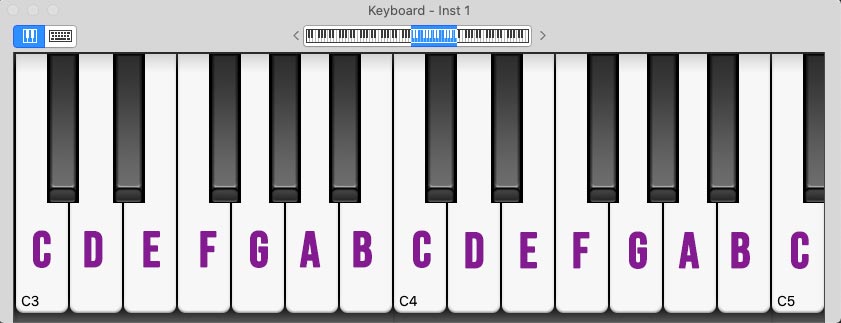
A semitone is the smallest interval betwixt two notes. It's too known as a 'half step'. Let's take a look at two semitone examples:
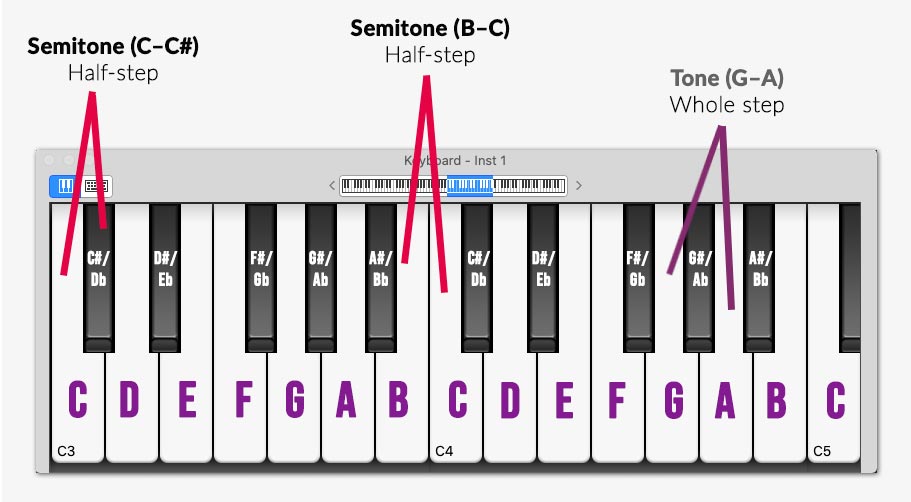
In the example, notes C – C# and B – C is a semitone. K – A, however, is a tone.
So why is knowing all this important?
That's because if you want to transpose a song from the key of C to D, yous then need to raise the pitch not by one, but by ii semitones!
See how nosotros're putting our music theory noesis to utilize?
And so which software do I need for pitch-shifting?
Luckily for the states, pitch shifting effects are quite common. Most sound editing and digital sound workstation (DAW) has it included out of the box.
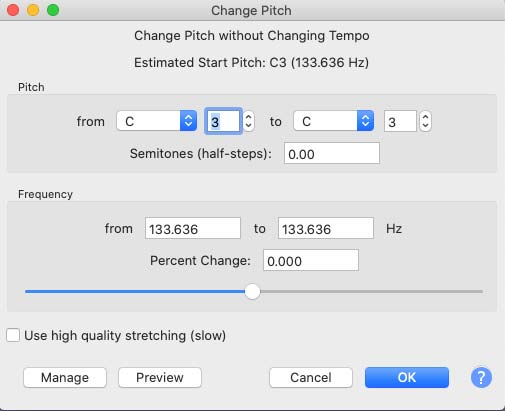 The pitch shift issue in Audacity.
The pitch shift issue in Audacity.
Make sure to check the manuals of your DAW if you're unable to detect a pitch shift function.
Otherwise, I'd recommend you to use Brazenness, an open-source audio editing software that you lot can download for costless.
The steps to doing pitch shifting might be different on different sound software and systems. Nevertheless, fundamentally, the process of transposing (pitch-shifting) a song or sample is the aforementioned.
That's why it's important to first understand how pitch-shifting and transposition works.
Will pitch-shifting dethrone the quality of a song or sample?
Although pitch-shifting furnishings and algorithms tin can exist quite advanced these days, still a pitch-shifted vocal will not accept its original quality.
Nevertheless, we can endeavour to lose as little quality as possible by using loftier-quality audio files or samples with a loftier sample rate of 96kHz or above, instead of the usual 44.1kHz or 48kHz.
Granted, this is not always possible. However, just keep in mind to utilise lossless audio file formats and get them at the highest sample rate possible.
And what well-nigh irresolute a vocal'southward pitch without changing its speed?
Pitch shifting is a combination of time stretching and up/down-sampling. This means every fourth dimension yous exercise a pitch shift, the timing of the song or sample changes and goes out of sync.
Especially for vocal samples, pitch-shifting often distorts its formants causing the output results to sound similar chipmunks (if pitched also high) or grouchy robots (if pitched likewise low).
Luckily pitch-shifting effects have evolved over the years. Without going into besides much details, generally – at that place are 2 types of pitch-shifting algorithms:
- Tape/Sampler: Sometimes referred to as 'varispeed', this method involves increasing or decreasing the playback speed to raise or lower the pitch. If you ever heard the 'sped-upwardly' (chipmunk) or 'powering downward' sound of a record player, that'due south tape pitch shifting in activeness.
- Time-independent: About modernistic pitch-shifting effects use this method, where pitch and fourth dimension are asunder and candy separately, so the playback speed isn't affected.
Followed well and so far? Nosotros've gone through the fundamentals of pitch shifting. Now, let's put everything we've learned into practice.
Walkthrough: How to Change the Pitch of a Song or Sample
In this walkthrough, I'll be using Audacity to change a song'due south original pitch. Fifty-fifty if yous prefer using a different audio editing software, follow along, as you'll learn some fundamental techniques forth the way.
Let'southward get started.
Because my song had vocals in it, I candy it with PhonicMind, our stem maker, and downloaded a karaoke version of the song in .flac (lossless audio format).
Click hither to learn how to remove vocals from songs.
Here's the music rail I used (notice the vocal's pitch.):
Song: Si Fuera Yo by StudioMonkey
Step i - Load your music or sample into Audacity
Launch Audacity and drop your audio file into the editing window.
Every bit mentioned earlier, call back to use a lossless audio file format with a high sample rate of 96kHz, if possible.
Yous'll see the sound waveforms load on Audacity, subsequently dropping the sound file.
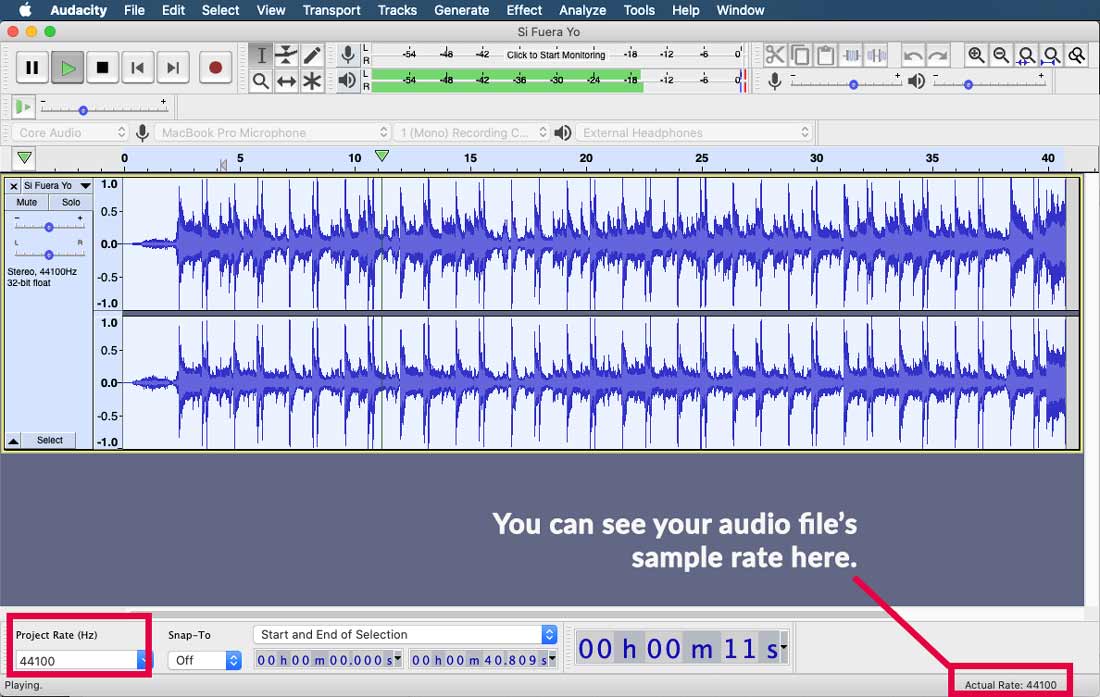
Step 2 - Select the 'Change Pitch' effect
Because nosotros want to change the pitch of the unabridged song, select the whole song past striking Ctrl+A (Windows) or Command+A (Mac). Alternatively, you could also click on 'Select' on the track's control panel.
Once selected, click on the 'Furnishings' drop bar and select 'Change Pitch'.
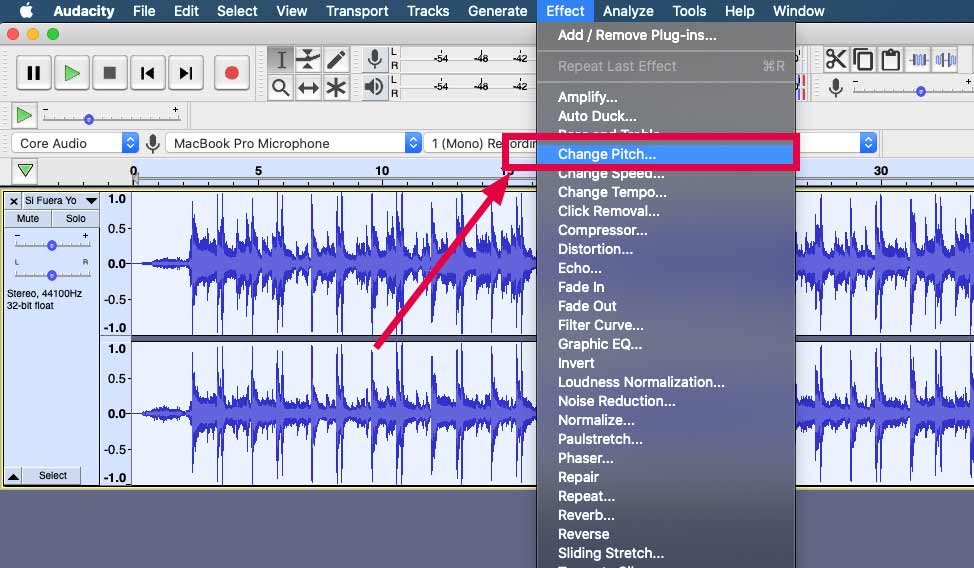
The event window volition launch and yous'll see some settings that at present, hopefully, make sense to you.
You'll observe that we have 3 options for changing the pitch of the song:
- A change from one pitch to another.
- A change in semitones (increase or subtract)
- A alter from one frequency to some other.
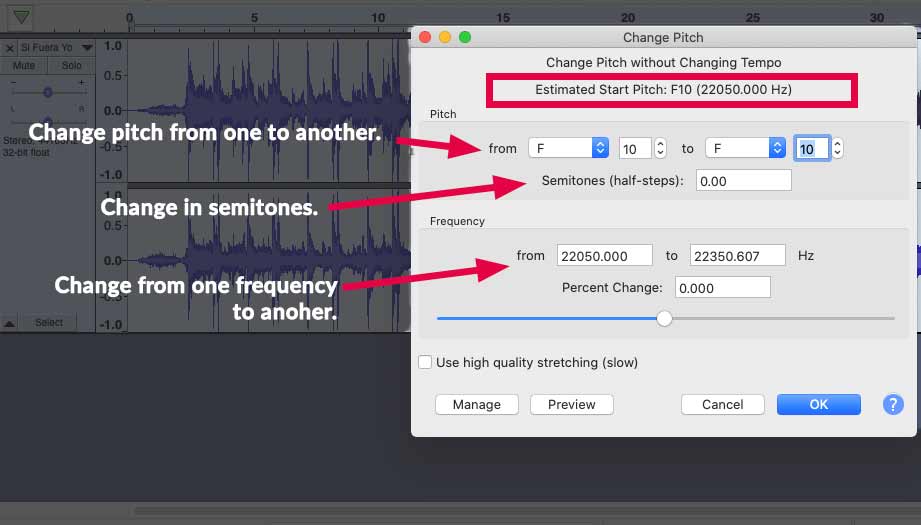
The pitch consequence also estimates the pitch of the song. In my instance, it detected that my vocal is in the key of F.
Pace 3 - Select pitch shift settings and process!
The easiest and most authentic way to change your song'south pitch is to modify it past semitones.
Usually, there'southward no need to raise or lower a song'southward pitch past whatsoever more than 4 semitones. Remember, the wider your transposition, the more you degrade the quality.
In my example, the cardinal of the song was too high for me to sing along to, and then I decided to lower the pitch by 1 semitone (half-step).
On the effects window, I entered -1 in the semitones column.
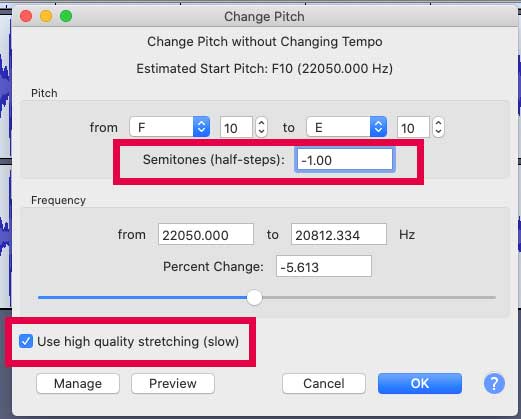
Brand sure to check the 'Use high-quality stretching (slow)' option. Having information technology checked ways the effect will take a longer processing fourth dimension but output a college quality issue with fewer audio artifacts and baloney.
One time prepare, but hit on 'OK'. Audacity will usually take simply a few seconds to procedure the entire song.
Here'south how the final output sounds (original and pitch-shifted):
And that's it! You've successfully inverse the pitch of your song or sample.
Bonus: Avant-garde pitch shifting.
In our walkthrough earlier, we pitch-shifted the entire song by transposing the unabridged track.
While that is the general fashion of transposing a song, what happened is that every element, including drums, bass, guitars, and other elements are processed. And the affair with pitch shifting is that the more nosotros process, the more audio artifacts we inevitably innovate into the song.
But what if we tin transpose but the tonal elements of the vocal and leave any atonal elements like the drums, unprocessed?
This is where we can become artistic using PhonicMind, our stems maker. Let's put this to the test.
Step 1 - Use PhonicMind to create stems.
PhonicMind is a stems maker that we've built with an AI-based engine. Caput to the homepage, click on 'Convert', and drop a song into the upload window.
Simply the same equally processing any audio files, e'er kickoff with a high-quality lossless audio file whenever possible. PhonicMind will take a few minutes to procedure the song and once done, yous can preview the audio stems before performing a full conversion.
For this example, I used the same vocal from the earlier walkthrough.
The difference this time is instead of choosing to download the karaoke version, I chose to download stems.flac.zip instead. This gives me four audio stems – vocals, drums, bass, and others.
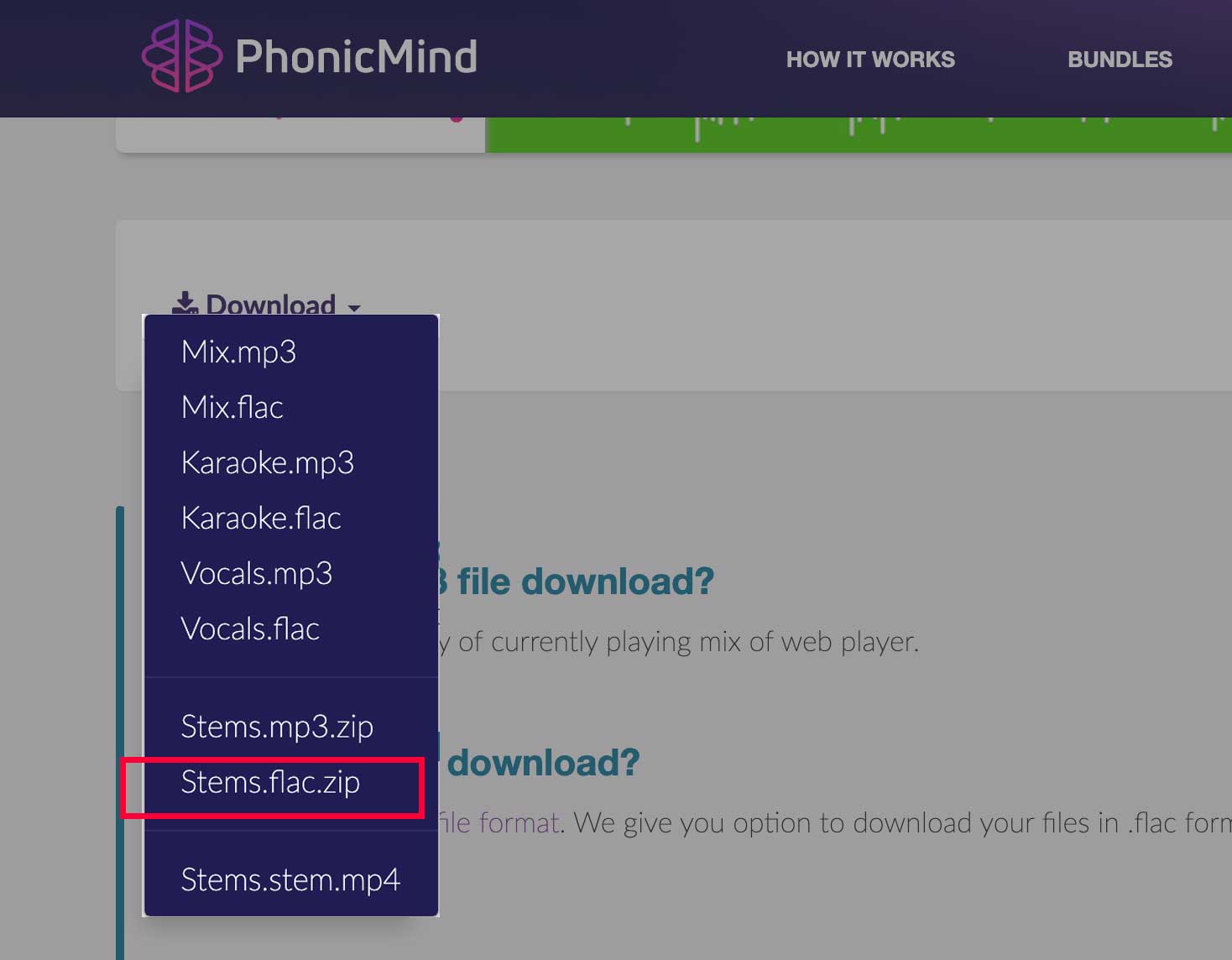
Once the download is complete, use a file archiver like 7zip to unzip the file. Yous'll detect the four separate audio stems in .flac format.
Step 2 - Change the pitch of the tonal stems.
Next, launch Brazenness and drop all four of the audio stems into the editing window. This loads all 4 audio stems as multi-tracks in Audacity.
In my example beneath, I've colored the drum track red and left the others in default blue – to clearly see the tracks.
Just similar what we did before, go ahead and alter all tonal-based stems' pitch, raising or lowering them to your wanted pitch – except the drum stem. The drum sound is an atonal chemical element, so we want to retain its original sound.
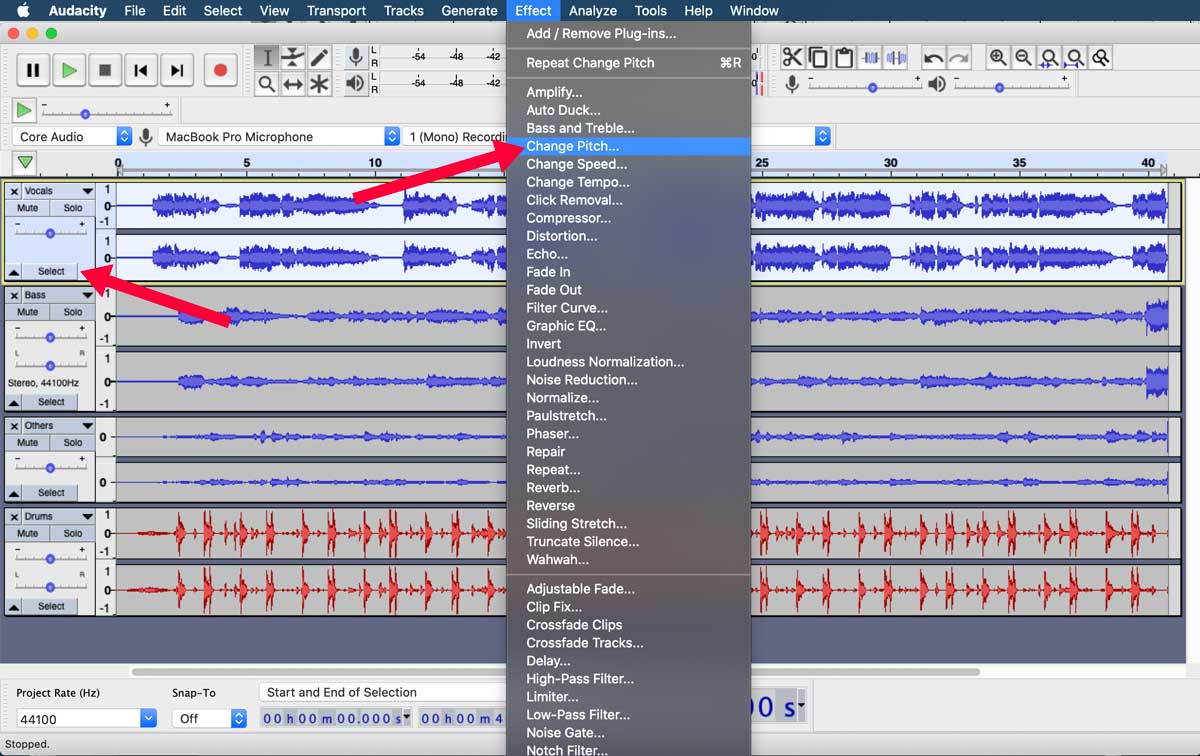
Starting with the kickoff rail, click 'Select' to select the entire runway. And so click the 'Consequence' drop bar and select 'Modify Pitch'. Process the track following the steps we've gone through the earlier walkthrough.
Repeat the same process for each tonal-based sound stems – vocals, bass, and others.
Step 3 - Mix and consign the final track.
In one case you're washed with individually transposing each tonal-based audio stems, preview the entire mix by hitting the play push in the transport window.
Mix the tracks by reducing or increasing the gain (volume) of each rails, while carefully listening for whatever clipping on the main output.
Once y'all're happy with the mix, choose to export your tracks as a stereo file (File > Export > Export as WAV). I chose to consign the mix in WAV (16bit) format to get a high-quality audio file.
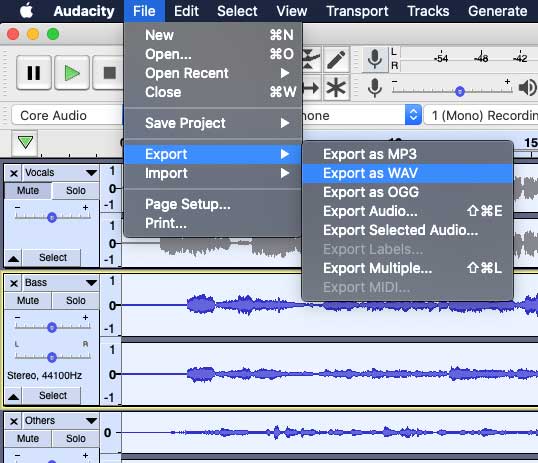
And that'southward it!
Scout the video below to hear the departure betwixt directly pitch-shifting the entire song, versus pitch-shifting simply the tonal parts of the song:
Discover how the drums are punchier and more than pronounced in the version in which we pitch-shifted only the tonal parts.
Conclusion
Past now, you should know how to alter the pitch of any song or audio sample. Try changing the pitch of a few of your favorite songs and encounter what you discover.
Once yous're familiar with the process, move into avant-garde pitch-shifting by breaking down the vocal into a few sound stems and pitch-shift only tonal-based stems, earlier mixing them back together.
Happy experimenting!

Reuben
Audio Mentor
-----
"Music producer and marketer. I create positive change!"
How To Change Files Pitch In Fl Studio,
Source: https://phonicmind.com/change-pitch-song/
Posted by: jamesfarinell1998.blogspot.com


0 Response to "How To Change Files Pitch In Fl Studio"
Post a Comment